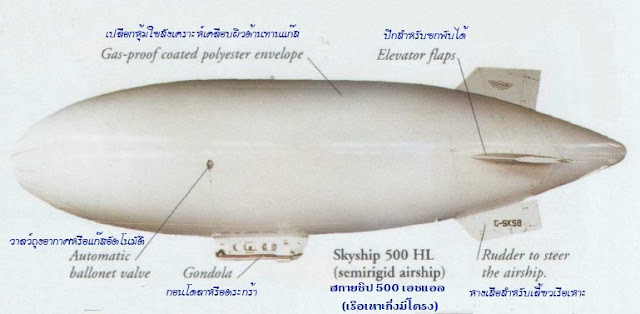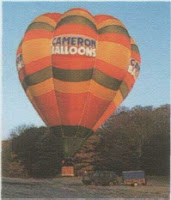AIRSHIPS
AND BALLOONS
AIRSHIPS AND BALLOONS are
known as lighter-than-air
aircraft because, instead of wings,
they use a large envelope, or bag, full of gas or hot air that is lighter than the air in the atmosphere around it. The air pushes the envelope upwards, just as water pushes a submerged air-filled ball upwards. In 1783, the Montgolfier brothers achieved the first manned flight ever by sending a hot-air balloon over Paris. Balloons fly where the wind blows them; airships have engines and can be steered. Today, airships are used for aerial filming and coast-guard patrols, and ballooning is a popular sport.
they use a large envelope, or bag, full of gas or hot air that is lighter than the air in the atmosphere around it. The air pushes the envelope upwards, just as water pushes a submerged air-filled ball upwards. In 1783, the Montgolfier brothers achieved the first manned flight ever by sending a hot-air balloon over Paris. Balloons fly where the wind blows them; airships have engines and can be steered. Today, airships are used for aerial filming and coast-guard patrols, and ballooning is a popular sport.
เรือเหาะและบอลลูน
เป็นที่ทราบกันว่าเรือเหาะและบอลลูนเป็นอากาศยานที่เบากว่าอากาศ แทนที่จะใช้ปีก อากาศยานเหล่านั้นมีเปลือกห่อหุ้ม (เอนเวลลอป) หรือถุงขนาดใหญ่เต็มไปด้วยแก๊สหรืออากาศร้อนซึ่งเบากว่าอากาศในบรรยากาศรอบ ๆ ตัวมัน อากาศจะดันเปลือกห่อหุ้มขึ้นด้านบน เหมือนกับน้ำดันลูกบอลซึ่งจมอยู่ใต้น้ำที่เติมอากาศเข้าไปให้ลอยขึ้นบนพื้นน้ำ เมื่อปี ค.ศ. 1783 (พ.ศ. 2326) พี่น้องมงกอลฟีเย (Montgolfier brothers) ประสบความสำเร็จในการบินที่คนจัดการได้เป็นครั้งแรกด้วยการส่งลูกบอลลูนที่มีอากาศร้อนขึ้นไปเหนือกรุงปารีส ลูกบอลลูนบินขึ้นไปตรงที่ลมพัดเข้าไปในตัวมัน เรือเหาะมีเครื่องยนต์และสามารถบังคับเลี้ยวได้ ปัจจุบัน เรือเหาะถูกใช้สำหรับการถ่ายทำภาพยนตร์ทางอากาศ (ก่อนที่จะมีโดรนเข้ามาแทนที่) และลาดตระเวนชายฝั่งทะเล บอลลูนยังเป็นกีฬาที่นิยมอีกด้วย
เป็นที่ทราบกันว่าเรือเหาะและบอลลูนเป็นอากาศยานที่เบากว่าอากาศ แทนที่จะใช้ปีก อากาศยานเหล่านั้นมีเปลือกห่อหุ้ม (เอนเวลลอป) หรือถุงขนาดใหญ่เต็มไปด้วยแก๊สหรืออากาศร้อนซึ่งเบากว่าอากาศในบรรยากาศรอบ ๆ ตัวมัน อากาศจะดันเปลือกห่อหุ้มขึ้นด้านบน เหมือนกับน้ำดันลูกบอลซึ่งจมอยู่ใต้น้ำที่เติมอากาศเข้าไปให้ลอยขึ้นบนพื้นน้ำ เมื่อปี ค.ศ. 1783 (พ.ศ. 2326) พี่น้องมงกอลฟีเย (Montgolfier brothers) ประสบความสำเร็จในการบินที่คนจัดการได้เป็นครั้งแรกด้วยการส่งลูกบอลลูนที่มีอากาศร้อนขึ้นไปเหนือกรุงปารีส ลูกบอลลูนบินขึ้นไปตรงที่ลมพัดเข้าไปในตัวมัน เรือเหาะมีเครื่องยนต์และสามารถบังคับเลี้ยวได้ ปัจจุบัน เรือเหาะถูกใช้สำหรับการถ่ายทำภาพยนตร์ทางอากาศ (ก่อนที่จะมีโดรนเข้ามาแทนที่) และลาดตระเวนชายฝั่งทะเล บอลลูนยังเป็นกีฬาที่นิยมอีกด้วย
Anatomy
of a modern airship
The
main part of an airship is its envelope, which contains
bags of helium gas. The gas is slightly pressurized to keep the envelope in shape. A fin and
tailplane keep the airship steady as it flies slowly along. The crew travels in a gondola attached to
the underside of the envelope.
กายวิภาคของเรือเหาะสมัยใหม่
ส่วนสำคัญของเรือเหาะก็เปลือกห่อหุ้ม ซึ่งบรรจุถุงแก๊สฮีเลียม แก๊สนั้นมีแรงดันเล็กน้อยเพื่อรักษาเปลือกห่อให้อยู่ในหุ้มรูปทรง หางเสือและแพนหางจะรักษาเรือเหาะให้พร้อมในขณะที่มันลอยไปอย่างช้า ๆ ลูกเรือจะเดินทางไปในตะกร้า (gondola = เรือกอนโดลา) ที่ติดอยู่ด้านใต้เปลือกหุ้ม (ดูภาพ)
ส่วนสำคัญของเรือเหาะก็เปลือกห่อหุ้ม ซึ่งบรรจุถุงแก๊สฮีเลียม แก๊สนั้นมีแรงดันเล็กน้อยเพื่อรักษาเปลือกห่อให้อยู่ในหุ้มรูปทรง หางเสือและแพนหางจะรักษาเรือเหาะให้พร้อมในขณะที่มันลอยไปอย่างช้า ๆ ลูกเรือจะเดินทางไปในตะกร้า (gondola = เรือกอนโดลา) ที่ติดอยู่ด้านใต้เปลือกหุ้ม (ดูภาพ)
Types of airship
Practical airships could be built only after the lightweight internal combustion engine had been developed. The earliest airships were "nonrigid" (they are still used today). These were followed by the "rigid" and the less usual "semirigid" types of airship. เรือเหาะที่ใช้การได้จริงควรสร้างขึ้นได้เฉพาะเมื่อมีการพัฒนาเครื่องยนต์สันดาปภายในที่มีน้ำหนักเบา เรือเหาะลำแรกสุดคือ "เรือเหาะแบบไร้โครง" (ปัจจุบันยังคงใช้อยู่) ตามด้วย "เรือเหาะแบบมีโครง" และ "เรือเหาะกึ่งมีโครง" ซึ่งมีน้อยกว่าปกติ | |
Nonrigid airships
have ,1 flexible fabric envelope, from which the load hangs, suspended by ropes.
เรือเหาะไม่มีโครงจะมีเปลือกห่อหุ้มเป็นโครงสร้างที่มีความยืดหยุ่น มีสัมภาระห้อยอยู่ผูกติดด้วยเชือก
|
Rigid airship's envelope is built around a rigid framework. This skeleton contains bags of the lifting gas - helium.
|
Balloons
Balloons were first
used for aerial reconnaissance during the French
Revolution, and used again in the American Civil War. During World Wars I and II, balloons were
used to spot targets for artillery attacks, and barrage balloons defended cities against
aircraft.
ลูกบอลลูน ลูกบอลลูนใช้เป็นครั้งแรกสำหรับลาดตระเวนทางอากาศในช่วงการปฏิวัติฝรั่งเศส และใช้อีกครั้งในสงครามกลางเมืองอเมริกา ในช่วงสงครามโลกครั้งที่ 1 และครั้งที่ 2 ลูกบอลลูนใช้เป็นจุดเล็งเป้าสำหรับการโจมตีนของปืนใหญ่ และลูกบอลลูนใช้ป้องกันเมืองจากการโจมตีทางอากาศ
|
|
Weather and research balloonsTo study what is happening in the upper reaches of the atmosphere, pilots send up helium-filled weather balloons. These carry instruments which measure temperature, wind speed, and so on, and send their results to the ground or to satellites by radio.
เพื่อการศึกษาว่าจะมีอะไรเกิดขึ้นในขอบเขตด้านบนของชั้นบรรยายกาศ นักบินได้ส่งลูกบอลลูนขึ้นไปสำรวจบรรยากาศที่เติมแก๊สฮีเลียม นักบินเหล่านี้ได้ขนเครื่องมือหลายอย่างสำหรับวัดอุณหภูมิ ความเร็วของลมและอื่น ๆ ตลอดจนได้ส่งผลกลับมายังพื้นดินหรือไปยังดาวเทียมทางวิทยุ |
Balloon festivals
Today, ballooning is a popular sport. During the summer, ballooning enthusiasts gather at festivals to enjoy the dazzling prospect of dozens of brightly coloured balloons flying together. Some of the balloons are owned by companies, and are made in the shapes of their products, as a form of advertising.
เทศกาลลูกบอลลูน ปัจจุบันนี้ การเล่นลูกบอลลูนเป็นกีฬาที่เป็นที่นิยม ในช่วงฤดูร้อนผู้นิยมการเล่นกีฬาบอลลูนจะมารวมกันในเทศกาลเพื่อสนุกสนานรื่นเริงกับโอกาสอันแพรวพราวของลูกบอลลูนที่มีสีสันสว่างไสวลอยอยู่ด้วยกัน ลูกบอลลูนบางลูกจะมีบริษัทเป็นเจ้าของและทำเป็นรูปของผลิตภัณฑ์บริษัทของตนเองเป็นรูปแบบการโฆษณา |
Flight
Hot-air ballooning requires a perfectly clear day with a gentle breeze. Too high a wind puts the balloon at risk on take-off and landing. After take-off, a
ground crew follows the balloon in a
vehicle to recover both it and the crew after
landing.
การบิน
การเล่นบอลลูนที่มีอากาศร้อนจำเป็นต้องเล่นในวันที่ฟ้ากระจ่างอย่างแท้จริงพร้อมทั้งมีสายลมอ่อน ๆ ลมแรงเกินไปจะทำให้บอลลูนเสี่ยงในเวลาลอยขึ้นและลง หลังจากการลอยขึ้น ลูกเรือที่อยู่บนภาคพื้นดินจะติดตามไปกู้ลูกบอลลูนและลูกเรือหลังจากลงถึงพื้นดินแล้ว |
||||
1 The balloon is laid on the ground. Burners heat air to fill the balloon.
1. ลูกบอลลูนจะถูกวางลงบนพื้นดิน
คนจุดไฟจะทำอากาศให้ร้อนเพื่อเติมลูกบอลลูน
|
2. เปลือกหุ้มบอลลูนจะขยายออกในขณะที่เติมอากาศร้อนเข้าไป
2The
balloon's envelope expands as the hot air starts
to fill it.
|
3 The
expanding balloon becomes buoyant, and rises
into the air.
3. ลูกบอลลูนที่ขยายตัวลอยขึ้น
และลอยขึ้นไปในอากาศ
|
4 Guy
ropes hold the balloon down until the crew
boards.
4. เชือกโยงจะยึดลูกบอลลูนไว้จนะกระทั่งลูกเรือจะขึ้นบนบอลลูน
|
5 The crew blasts hot
air into the envelope to keep the
balloon afloat.
5. ลูกเรือจะพ่นอากาศร้อนเข้าไปในเปลือกหุ้มเพื่อให้ลูกบอลลูนลอยขึ้น
|













